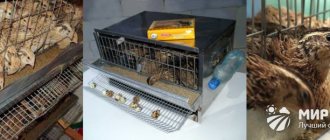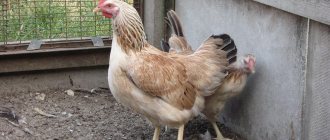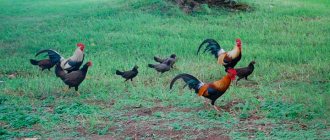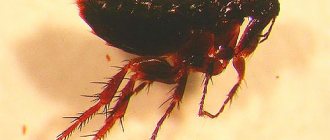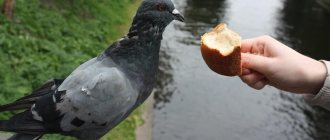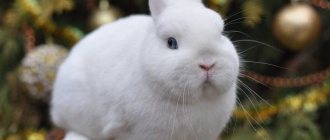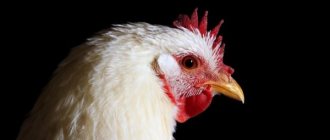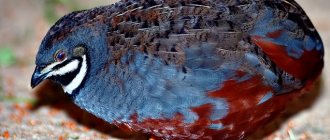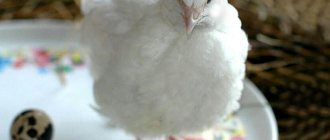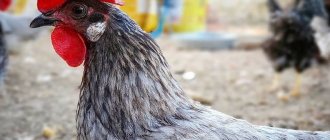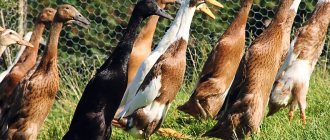Doves are a symbol of meekness, humility and marital fidelity. The famous director Sergei Obraztsov was very fond of pigeons. And boxer Mike Tyson preferred pigeons to Bengal tigers. There are a huge number of their breeds. There are racing, high-flying, tumblers and fighting, homing and sporting, handsome decorative and giant meat pigeons. I’ll tell you about keeping pigeons in the household in my article.
Features of keeping pigeons in the household
What you need to know about dovecotes
Pigeons can be kept in:
- enclosures;
- nurseries;
- cells.
The type of dovecote depends on the purpose of keeping, the number of birds, their breed, the natural features of the area and the capabilities of the breeder.
The ideal place for breeding pigeons in rural areas is an attic dovecote.
If you plan to keep a small number of pigeons, then hanging nests are suitable. Such a home provides complete freedom for pigeons.
For urban residents, an acceptable option would be to build a poultry house on the ground. For example, a free dovecote, which is mounted on a pole.
It is better to place the dovecote away from tall buildings and trees that interfere with birds taking off and landing. The breeder also runs the risk of leaving pigeons uncontrolled for a long time, since the birds will land on the roof of a high-rise building or the top of a tree. The close proximity to a dovecote can also cause a lot of trouble for owners of balconies in a residential building - pigeons will pollute them. Wires can interfere with the flight of birds and even lead to their death, so you should build a dovecote away from them.
To avoid infections, the dovecote should be placed away from garbage pits and farms.
Pigeons must find their home easily, so the home must have an identifying color and shape.
Suitable materials for construction:
- brick;
- tree;
- metal;
- boards and plywood (for interior cladding).
The room should be equipped with ventilation and electricity, and if necessary, connect an artificial heat source.
Breeds for breeding by beginning pigeon breeders
The existence of several species of pigeons is known:
The simplest ones, which do not require special knowledge, are decorative and meat . The former have many distinct traits that cause admiration, the latter can compensate for the initial costs of breeding and bring tangible profits.
Sports and racing breeds require careful attention, knowledge of the training process and understanding of bird biology . If a novice pigeon breeder is not a specialist in the field of ornithology, then it will be difficult for him to engage in this area of pigeon breeding.
Arrangement of enclosures
For walks, sun and water baths, as well as to prevent obesity, pigeons need an aviary. It is installed on the ground, stand and roof or suspended. The more spacious it is, the better - at least 5 m in length and 3 m in width.
The structure must be strong and close tightly. To prevent wild birds, which are carriers of infections, from entering the pen, the front part is fenced with fine-mesh mesh. From the north and east, the pen is covered with plywood or plastic.
It is better to concrete the floor or cover it with cement, this will make it easier to clean and disinfect. Dirt flooring should be replaced annually to avoid contamination from coccidiosis and other soil-borne diseases.
To equip the walking area you will need:
- feeder;
- drinking bowl;
- bath;
- box of greens.
How to care for pigeons
The health of pigeons, their behavior and the beauty of their plumage depend on the care of the birds.
It is recommended to clean the dovecote daily. Feeding and drinking equipment should be boiled or doused with boiling water and soda every month.
Thorough cleaning is carried out twice a year. It also involves disinfection, so the pigeons are removed from the premises. After disinfection, whitewash is applied to the walls, the floor is washed and the pen is ventilated for at least an hour. If it is not possible to remove the birds from the dovecote, the room is not disinfected, but whitewashing is done.
Change the litter as necessary. The bathhouse is kept clean and the water in it is kept at room temperature and always fresh, since pigeons drink it during water procedures.
Every day during feeding, the birds themselves are examined. A healthy individual eats well and immediately flies to the food. A pigeon affected by the disease usually draws its head into its shoulders, closes its eyes, lowers its wings and sits ruffled. Such birds must be immediately isolated.
Daily care should include cleaning pigeons' claws of droppings that roll into balls, stick to the birds' feet and interfere with their walking.
So that the pigeons are not afraid of the breeder during feeding and cleaning, they must be tamed. For this purpose, the pigeon breeder is recommended to come to the birds in special clothes and feed them with seeds.
Is it possible to do without building a special room at the initial stage?
Pigeons should always be kept separate from any poultry. This will avoid the spread of diseases and create optimal living conditions for pigeons. Therefore, it is wrong to keep them in a chicken coop or poultry house. They need a separate room with a walking area, a place to rest after flights, and a mast for guidance and determining the direction of the wind.
If you build a small dovecote for 3-4 pairs, and then expand it to accommodate offspring, this will lead to additional costs. It would be advisable to build a dovecote for 10-20 pairs and fill it with new generations of birds within one year.
What microclimate should there be in a dovecote?
Important factors for breeding pigeons are:
- light;
- Fresh air;
- temperature regime.
The poultry house should not be cramped; it must be well ventilated and protected from drafts. It is necessary to ensure that the air in the room is fresh and moderately humid. The sun's rays should freely penetrate the dovecote. It is better if the front side of the building faces south or southeast.
Temperature
In winter, it is necessary to maintain the temperature in the room no lower than 5-7 ⁰С, and in summer no higher than 20 ⁰С. Too high a temperature will have a bad effect on the health of the birds, and will also provoke the appearance of ticks and bedbugs. Pigeons do not tolerate heat well, so it is not recommended to force them to fly in hot weather. To help pigeons cope with the heat more easily, you can water the roof of the dovecote with water.
Hypothermia, which can cause infection, is no less harmful for birds. Overcooled chicks fall into a stupor.
Lighting
For the normal development of the pigeon's body and increasing its productivity, long daylight hours are necessary. Shortened daylight hours, as well as red and orange light, stop the puberty of young animals and accelerate physical development.
Ventilation
Excess carbon dioxide, which is produced during respiration, negatively affects the pigeons' appetite and the health of the birds' bones. Ammonia, which is produced during the decomposition of feces, also has a detrimental effect on the body of birds. Optimal air composition can be achieved through ventilation.
Optimal number of pairs
In the first place, of course, is the price. You can take one pair and create ideal conditions for it to live and develop, but after the flock, singles and even couples will be bored in the dovecote. They will begin to eat poorly, and when flying out they may fly away, carried away by another flock.
It would be reasonable to buy at least three pairs from different nests. This will allow you to breed your breed within two to three years, crossing and culling unrelated offspring from the purchased bird.
How to organize food for pigeons
The basis of food for pigeons in the wild is green grass, seeds and grain. This food is easily digested by birds and is ideal for them, given the characteristics of their gastrointestinal tract. Therefore, it is better if domestic pigeons eat according to the same principle. If the keeping is free, then they provide the bulk of the food for themselves; in other cases, the poultry farmer must organize a balanced diet for his pets.
To organize feeding processes and provide water for pigeons, you will need feeders and drinkers. Devices must be easy to clean and disinfect. To avoid excess debris getting into the food, preference should be given to feeders that only the pigeon’s head can fit through. For mineral feeding you need to have separate feeders. It is preferable to have drinkers made of glass or other non-oxidizing material. The amount of food depends on the breed of pigeons. On average, an adult bird eats 30 grams of feed per day. The number of feedings in summer and winter will be different - in summer three meals are needed, and in winter two are enough.
The composition of the feed should contain:
- Barley – 40%. It can be replaced with pearl barley.
- Millet - 10%.
- 30% - wheat.
- 10% - legumes, seeds, corn, oatmeal.
- 10% - green grass. You can give nettles, alfalfa, cabbage or sorrel.
It is better to sow greens directly in the enclosure. You can also allocate a special box for meadow grasses.
The offspring can obtain the necessary minerals from charcoal, ground eggshells or shells. It is recommended to include table salt in the diet - 20 grams. for 1 l. water. In specialized stores you can purchase vitamin and mineral supplements that will help raise healthy animals, as well as avoid vitamin deficiency and its consequences. If necessary, you can also buy ready-made food for pigeons or parrots.
Basics of proper feeding
Principles of feeding pigeons:
- The basis of the diet is barley. Carrots, apples, and potatoes are added to it. Barley can be substituted for barley.
- There must be wheat in the daily diet. The speed increases during molting and raising offspring.
- This complete and nutritious grain mixture contains millet. This food gives the birds a lot of energy. The mile is especially needed for sporting breeds when flying long distances.
- There are legumes on the menu. Many of them are not given so as not to cause obesity. Legumes are needed during the molting period, during transportation, reproduction and raising of offspring.
- Peeled oats or oat flakes are added to the grain mixture.
- In the warm season - fresh grass.
- It's important to meet your protein needs. If birds do not receive protein, then its absence is compensated for some time by carbohydrates and fats, then the body begins to consume proteins intramuscularly. But excess protein is also harmful: birds lose their productive qualities. The protein norm in the diet of pigeons is 13-15% of the feed volume.
- Fat-containing cereals and eggs are introduced into the diet of meat breeds.
- A person receives at least 40-50 g of feed per day. In winter, food tariffs increased.
- To strengthen the immune system, birds are watered with decoctions of chamomile, thyme and twine.
It is forbidden to feed pigeons:
- Fish. The body of these birds does not tolerate phosphorus well.
- Meat. The digestive system of pigeons is not suitable for digesting meat products. Birds may also die.
- Black bread. It causes a fermentation process in the stomach.
- Milk product. There are few lactic acid bacteria in the digestive tract of pigeons, and the digestion of dairy products is difficult.
- Sweets and products containing oil. The liver of pigeons cannot digest fatty foods. Oil can kill birds. Sunflower seeds can also damage them. If seeds are given, there are very few of them.
- Salt. In large quantities it is poison for pigeons. 1.5 g of salt is enough to kill a pigeon. Pigeons meet their salt needs with regular food.
For an adult bird
The feeding regimen of pigeons is determined by:
- season;
- condition of birds;
- lifestyle (open or closed dovecote).
Catering by season:
| Season | Number of feedings | Feeding time, h |
| Winter | 3 |
|
| Summer | 2 |
|
The diet is influenced by the lifespan of birds:
- Dumb. Lasts from March to November. The share of protein products is growing. A lack of protein leads to a delay in molting and the formation of poor-quality plumage - feathers with a dense web are formed.
- Reproduction. The period begins in March-April. Fish oil required - 10 ml per 1 kg of feed. They provide formulas high in protein, amino acids and minerals.
- Laying eggs. Begins 7-10 days after mating. Lasts 18-21 days. The food contains many vitamins, amino acids and minerals. A little greenery, potassium iodide (70 mg per 1 kg) and vitamin E (2-3 drops per 1 kg) are added to the food - these substances are necessary for the quality formation of eggs and fertilization.
- Winter period. The amount of protein is reduced to reduce the sexual activity of birds. It is recommended to add flax and rapeseed to your daily diet - 4 g per 1 kg. Legumes are excluded, wheat is reduced to a minimum. Give a mixture with boiled potatoes and bran.
Approximate rations for feeding pigeons, taking into account their lifespan:
| Life period | Peas, % | Vika,% | Grain, % | Mile, % | Barley, % | Corn, % | Oats, % | Rye crackers, % | Hemp, % | Sunflower, % | Lentils, % | Yeast, % |
| Dumb | winds | 10 | 10 | winds | 10 | 10 | winds | — | — | — | — | — |
| Reproduction | winds | — | 50 | — | winds | — | 10 | — | — | — | — | — |
| Laying eggs | — | 15 | thirty | 15 | — | — | 15 | 15 | 4 | 5 | — | 1 |
| Winter period | — | — | — | — | 40 | 10 | 40 | — | — | — | 10 | — |
Consequences of vitamin deficiency in pigeons:
| Substances not present in the body of pigeons | Deficiency Symptoms |
| Vitamin A | cessation of egg production, decreased hatchability, hatching of non-viable chickens |
| Vitamin B 2 | extinction of embryos, birth of non-viable chicks |
| Phosphorus, calcium, vitamin D | thin shell, no shell in eggs |
For young animals
The growth of young animals depends on the completeness of the diet. Young pigeons are more vulnerable to disease than adults. Disease incidence is reduced if the feed contains sufficient vitamins, minerals and other nutrients.
The first few weeks after leaving their parents, the young need a lot of food. They look at the iris, as soon as it becomes the same as that of adult pigeons, the portions decrease.
Features of feeding young animals:
- The portion in the morning is smaller than in the evening.
- The grain is watered with fish oil.
- In order for the young to grow well, they are fed with a mixture of barley, peas and vetch.
- When pigeons learn to fly, they give half the grain - they replace it with peas and vetch, taken in equal parts.
For one individual - 40 g of food. An example of a mixture of cereals for feeding:
- wheat - 20%;
- vetch - 10%;
- peas - 10%;
- corn - 10%;
- barley - 20%;
- millet - 30%.
As the bird grows, beans are added to the diet, reducing the amount of vetch.
Late pigeons are given an improved diet: refined rice, corn grits, millet, nutritional yeast and fish oil are added to the grain (5 drops per day). A 5% glucose solution is added to water%.
Juicy green food is given to young animals daily - 10 g per day for each individual. Potatoes and cereals are used as additives, but they cannot be given without cereals - the birds will have digestive problems.
What diseases do pigeons have and how to treat them?
To maintain health among livestock, the main criteria are proper care, balanced nutrition and disease prevention in the form of vaccines.
But sometimes even following all the rules does not save you from various kinds of avian diseases, to which pigeons are also susceptible. In this case, it is necessary to react quickly and notice the symptoms of the disease as early as possible.
The table shows the main diseases, their symptoms and what treatment is used for pigeons for a particular disease.
| Name | Symptoms | Treatment |
| Smallpox | At the initial stage of the disease, red spots appear near the beak, eyes, ears, as well as on the joints and paws of birds. Then the spots near the beak turn yellow, and mucus is released from the eyes and nose. | Pre-vaccination. Treatment with antibiotics and albuvir. |
| windmill | This virus affects the nervous system of pigeons, which primarily affects their gait. Other symptoms include fever, loss of balance and appetite. | Vaccination. Lozeval, Fosprenil and Albuvir are used. Drugs that enhance immunity. |
| Psittacosis | Transparent fluid in the eyes and nose, change in eye color, change in breathing and wheezing, atrophy of the limbs, diarrhea. | Special drugs or Albuvir are used. Additionally, vitamins are used. |
| Paratyphoid | Infertility, diarrhea, ruffled feathers, lethargy, joint damage, decreased appetite | Vaccination. Special room treatment means. The use of special drugs and Albuvir. |
| Trichomoniasis | Destroys the liver. Externally it manifests itself in the form of yellow spots in the mouth, shortness of breath, lethargic behavior, diarrhea, loss of appetite, and bloating. | It is treated with a special drug for trichomoniasis. |
| Coccidiosis | It affects the intestines and does not appear externally for a long time. Symptoms: diarrhea, general malaise, lack of appetite, joint paralysis. | Compliance with sanitary standards in the premises. Special drugs and Albuvir. Fortification. |
| Worms | Decreased immunity, shaggy hair, dull plumage, weight loss, diarrhea. | Changing your diet. Use of dewormers. |
| Newcastle disease | Extreme thirst, diarrhea, cramps, loss of balance | Vaccination |
| Tuberculosis | Weight loss, weakness, diarrhea, joint inflammation | Practically no cure |
| Candidiasis | Decreased appetite, weakness, diarrhea, goiter inflammation, discharge of curds. | Antibiotics and Albuvir. Fortification. Disinfection of the premises. |
How much feed should you give?
Experienced breeders are able to determine by eye the required amount of bird feed per day. You can determine whether pigeons are full by looking at their crop. If it looks full, it means the bird is well fed. After feeding, it is necessary to remove all feeders from the dovecote. This way, the remaining food in them will not be scattered on the floor.
The diet and number of feedings are adjusted for the arrival of winter. During the cold season, pigeons need food high in fat and vitamins. For elasticity and shine of feathers, it is recommended to feed your pets flax and rapeseed.
How to breed pigeons correctly
Pigeons usually breed in the spring. The pigeon breeder must prepare in advance for this period. Pigeons can find a mate for themselves, but if the breeder monitors the cleanliness of the plumage and other show characteristics, then partners can be selected artificially. Artificial breeding of pigeons is also used for selection.
To distinguish a male from a female, you should first pay attention to the size of the pigeon - males are larger than females. The male can also be recognized by his behavior - he will begin to court the female, enlarging his crop and performing a mating dance.
With artificial fallowing, you can choose the female most suitable for reproducing offspring - these are medium-sized birds. Excessive weight of the hen will interfere with herself and will negatively affect the eggs and offspring, and if she is underweight, it will be difficult to hatch the offspring.
For each pair it is necessary to arrange a nest. A box can be used as a nest; round plaster or wooden nests are also used.
A week after mating, the female will lay an egg, and a day or two later the second will appear. It is recommended to ensure that the hen begins to hatch two eggs together. To do this, before the second egg appears, the first one must be carefully removed to a dark, warm place and replaced with an artificial one. After the chicks are born, the pigeons will throw the shells out of the nest.
Pigeon chicks
The female incubates the chicks from the eggs. Newborn babies are absolutely defenseless; they lack vision, feathers and fluff. The chick weighs only 10 grams. The chick's head is disproportionately large, so it is difficult for him to stand on his weak legs.
The chicks grow quite quickly. After 2 months, when the first moult has passed, only an experienced person can distinguish a young pigeon from an adult. The main signs by which one can understand that a pigeon is still young are clumsy movements, dull color of plumage and the absence of an iridescent border.
The pigeon chick receives nutrition in the form of a liquid similar to milk, which is formed and stored in the female's crop. Both parents are involved in raising children (warming, care, protection), leaving the nest only as needed.
Popular varieties for home keeping
All known pigeon breeds are divided (conditionally) into 4 main types:
- postal (sports);
- flying (racing);
- meat;
- decorative.
In pigeons living at home, there are often variants when representatives of the same breed belong to several groups at once. A flying breed that does not have the opportunity to train easily turns into a decorative one. At the same time, increased fattening and lack of physical activity turns ornamental animals into meat animals.
About
Using Dove Rings
Among experienced pigeon breeders, pigeon rings are widely used. Banding helps to record such important information about a pigeon as breed and age. If desired, you can put any other information on the pigeon rings - city, nickname and other features.
It will be easy for a breeder to distinguish birds from each other if he issues such “passports” to pigeons.
Pigeon rings are divided into open and closed. The first option cannot give an absolute guarantee that the information indicated on it is correct, since such rings for pigeons can be replaced. They can be used in private households. Closed rings are also called generic rings. They are put on eight-day-old birds and are not removed for the rest of their lives. The pigeon's front toes are threaded into the ring, and the back toe is carefully pulled along the metatarsus.
If a pigeon breeder keeps a stud book, then after banding the information from the ring is entered into it, usually the date of birth, color, and the number of the parents’ ring.
